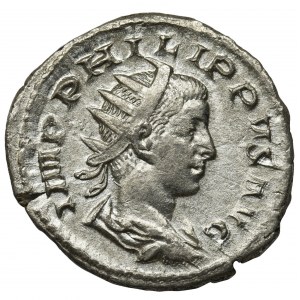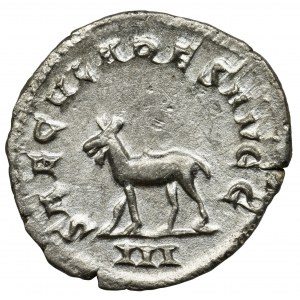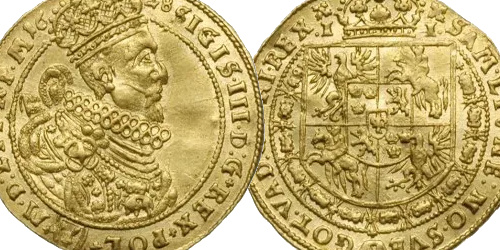Roman Imperial
Philip II (247-249), Antoninianus, Rome mint
Obverse: radiate and draped bust right
IMP PHILIPPVS AVG
Reverse: european moose walking left, III below
SAECVLARES AVGG
Weight 2.96 g
Archaeological records show that the place where Rome stood was inhabited from around 1000 BCE, but the official date of foundation of the city was April 21, 753 BCE. A thousand years later, the entire empire of the Romans celebrated the millennium of their civilization with magnificent games involving many exotic animals. The reigning Emperor Philip I did not miss the opportunity to preside over such an event and associate his family with the advent of the new one. For this occasion, he issued attractive coins that are eagerly collected due to their historical importance and various designs.
A careful examination of Philip's coins suggests that the emperor delayed the start of the Games because he was on the Danube front, battling the invasions of the Germans and the Carpathians. For this reason, he probably could not attend the festivities until the beginning of 248. Millennium coins were minted in gold, silver and copper and in several denominations. The obverse features a portrait of a royal family member, Philip I, his wife, Otacilia Severa, or their son, Philip II, who was elevated to the rank of co-emperor in 248. The backs of these coins usually appear with the legend SAECVLARES AVGG, suggesting that the celebration marked the end of one era and the beginning of another. The two remaining inscriptions on the millennium coins are SAECVLVM NOVVM, which means 'new era' and MILIARIVM SAECVLVM, which means the thousandth year. The main depictions on these coins are animals: lion, deer, antelope, european moose, hippo, elephant and she-wolf.
Interestingly, the coins of the Roman Mint depicting these animals were produced in various workshops (outbuildings). Each publishing house was assigned one animal with a Roman numeral (I, II, III, IIII, V or VI) in the episode. The lion was the subject of the first outbuilding, the she-wolf and twins in the second, the European moose in the third, the hippo in the fourth, the deer in the fifth, and the antelope in the sixth.
Archaeological records show that the place where Rome stood was inhabited from around 1000 BCE, but the official date of foundation of the city was April 21, 753 BCE. A thousand years later, the entire empire of the Romans celebrated the millennium of their civilization with magnificent games involving many exotic animals. The then reigning Emperor Philip I did not miss the opportunity to preside over such an event and associate his family with the advent of the new one. For this occasion, he issued attractive coins that are eagerly collected due to their historical importance and various designs.
A careful examination of Philip's coins suggests that the emperor delayed the start of the Games because he was on the Danube front, battling the invasions of the Germans and the Carpathians. For this reason, he probably could not attend the festivities until the beginning of 248. Millennium coins were minted in gold, silver and copper and in several denominations. The obverse features a portrait of a royal family member, Philip I, his wife, Otacilia Severus, or their son, Philip II, who was elevated to the rank of co-emperor in 248. The backs of these coins usually appear with the legend SAECVLARES AVGG, suggesting that the celebration marked the end of one era and the beginning of another. The two remaining inscriptions on the millennium coins are SAECVLVM NOVVM, which means 'new era' and MILIARIVM SAECVLVM, which means the thousandth year. The main depictions on these coins are animals: lion, deer, antelope, European moose, hippo, elephant and she-wolf.
Interestingly, the coins of the Roman Mint depicting these animals were produced in various workshops (outbuildings). Each publishing house was assigned one animal with a Roman numeral (I, II, III, IIII, V or VI) in the episode. The lion was the subject of the first outbuilding, the she-wolf and twins in the second, the European moose in the third, the hippo in the fourth, the deer in the fifth, and the antelope in the sixth.
Philip I presented five animals on his coins, the most impressive of which was the lion. It was an age-old symbol of royal power, especially familiar to Philip because his family was from a fairly remote part of the Middle East. Philip's other animals are deer and antelope. Scientists have presented different views on the identification of these two animals, differing from each other, but certainly not easy to identify. The deer has antlers with numerous points, while the antelope (sometimes described as a gazelle or ibex) has slender and curved ends. The european moose appears only on the coins of Philip II. This imposing creature with an upright figure, "beard" and horns looks distinctly different from the deer or antelope from his father's coins. The creature on Philip II's coins is sometimes described as a goat.
The most popular type of the reverse of the Otacilia Severa coins is the hippo, a creature that must have delighted the Roman public. Why it was dedicated only to her (as the european moose was exclusively for the son) we do not know.









